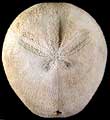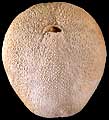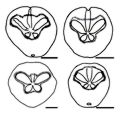|
Diagnostic Features
|
- Test ovate with effectively no anterior sulcus; posterior face truncate. Ambitus rounded.
- Apical disc ethmophract with four gonopores; central.
- Anterior ambulacrum sunken adapically; narrow, with differentiated pore-pairs rather densely packed.
- Paired ambulacra petaloid; petals bowed, sunken and open distally; inner pore circular, outer pore more elongate. Anterior petals much longer than posterior petals, which extend less than a quarter of the way to the ambitus. Not strongly pinched as they cross the peripetalous fasciole.
- Peristome D-shaped and a little tilted towards the anterior.
- Labral plate triangular with horn extending to one side. Sternal plates large, asymmetric, with an oblique suture. Episternal plates offset.
- Periproct small; positioned high on posterior truncate face.
- Peripetalous fasciole present; indented by one or two interambulacral plates behind the anterior petals.
|
|
Distribution
|
Upper Cretaceous (Cenomanian to Maastrichtian), ?Miocene; USA, Europe, North Africa, Middle East, India. |
| Name gender |
masculine |
| Type |
Hemiaster leymeriei Agassiz, 1847, p. 122, by original designation. |
| Species Included |
- L. leymeriei (Desor, 1855); Turonian-Coniacian, France.
- L. similis (d'Orbigny, 1854); Cenomanian, France.
- L. campestris van der Ham et al., 2011; Campanian, the Netherlands.
- L. maestrichtensis (Schluter, 1897); Maastrichtian, The Netherlands.
- L. eluvialis van der Ham, 1995; Maastrichtian, the Netherlands.
- L. sexangulatus (d'Orbigny, 1854); Maastrichtian, Turkey, India.
|
| Classification and/or Status |
Spatangoida, Hemiasterina, Hemiasteridae.
|
| Remarks |
Differs from Hemiaster in having a marked difference in the length of anterior and posterior petals. In the Maastrichtian species the fasciole is also noteworthy for following a straight line anteriorly from the tips of the anterior petals. However, this is not the case in the type species. The oblique sternal suture and lack of pinching of the ambulacra where they cross the peripetalous fasciole distinguish this from Holanthus.
Lambert, J. & Thiéry, P. 1909-1925. Essai de Nomenclature Raisonnée des Echinides. L. Ferrière, Chaumont, fasc. 1: i-iii, 1-80, pls. 1-2 (March 1909); fasc. 2: 81-160, pls. 3-4 (July 1910); fasc. 3: 161-240, pls. 5-6 (May 1911); fasc. 4: 241-320, pls. 7-8 (March 1914); fasc. 5: 321-384, pl. 9 (Sept. 1921); fasc. 6-7: 385-512 , pls. 10-11, 14 (Dec. 1924); fasc. 7-8: 513-607, pls. 12, 13, 15 (Feb. 1925) pp.
van der Ham, R. W. J. M., Jagt, J. W. M. & Janssens, H. J. 2011. Leymeriaster campestris, a new early Campanian hemiasterid echinoid from southern Limburg, the Netherlands. Netherlands Journal of Geosciences — Geologie en Mijnbouw 90, 179-185. |




